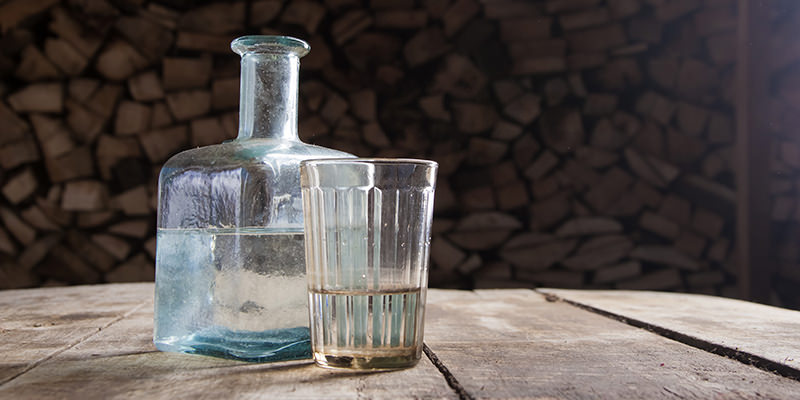Did you wake up in the middle of the night shouting “What the hell is white whiskey??!” Good, us too. And there’s a good reason it’s seeped into the collective unconscious. It’s out there, and (for some reason?) it’s not going away.
A few years ago, spirits aficionados and whiskey geeks were very busy falling into and out of love with white whiskey—aka “white dog,” or simply “new” or “unaged whiskey.” And in a craft spirits kind of market, that initial infatuation was hard to resist: white whiskey was something new but it also had historical street cred, borrowed (not entirely correctly) from moonshine. But even beyond its bad-boy country roots, white whiskey had an unexpected marketing edge: it could actually straddle the seemingly impassible gulf between darling (maybe too darling) aged American whiskey and the party-hard clear spirits category long dominated by vodka.
So yeah, we fell in love with the stuff. But just like after a long night and maybe one too many (white) whiskies, we woke up next to something a bit harsher than we’d remembered. And a bit younger. And we weren’t sure if we wanted to ask it to leave.
White whiskey is essentially a raw, unfinished product on its way to becoming grown-up whiskey. In the regular whiskey production process, a fermented, grain-based mash is distilled to higher proof (ABV) and aged for varying periods of time in oak barrels. White whiskey skips that last—theoretically essential—aging step and goes right to the bottle. Yes, to be called “whiskey” (just whiskey, not bourbon or rye or single malt, etc.) the spirit technically has to be stored in oak, but this could last as little as 10 seconds, imparting none of the caramel or wood or pepper or fruit or smoke we’ve come to know and love in our whiskies. What you get instead is basically naked grain. Highly alcoholic naked grain.
But what white whiskey really is, at least on some level, is an economic lifeline, a way for smaller distilleries to put a product on the market immediately while they wait for their barrel-aged whiskies to mature. And this makes a lot more sense to us as a rationale for bringing white whiskey to market. American whiskies age, and time is money. It’s as if you’d written a surefire best-seller but had to wait a few years before you could sell it. The best way for a distiller to get over that hump, until cryogenic freezing technology becomes casually affordable and they can just sleep it off, is to sell raw whiskey meanwhile.
Not that small-scale craft distilleries are just chucking hot hooch at their customer base. The idea is really to craft something interesting, and drinkable. And outcomes are variously palatable. Some white whiskies—many made with corn or wheat—can be smoother than others. And some, made with rye, can express the native fruitiness and pepper of the grain itself, which, especially in rye’s case, actually works OK in the context of a higher proof. (We should note, several white whiskies are very high proof, maybe because they’re trying to up that connection to moonshine, which no white whiskey on the market actually has, since moonshine, by definition, is illegal, untaxed, and ideally made by a shirtless dude in overalls.)
The funny thing about white whiskey—considering it’s cheaper to make than aged whiskey—is how expensive it can be. A quick online search for Few White Dog whiskey and you’ll get anywhere from $44 to $47. Hudson New York Corn Whiskey goes for over $40, and Death’s Door will go for about $35. The reason you’re hearing a bit more about it though, might have less to do with smaller craft distilleries than the big guys—Jack Daniels, Jim Beam, even Heaven Hill. Since white dog made its wild way onto the market via microdistilleries, it’s been successful enough for major distilleries to take note, and none too subtly follow suit. Not great news for the smaller distilleries, who depend on white whiskey economically, since major distilleries are able to sell their white dog at lower prices. There are exceptions though, in the “if you price it, they will buy it” spirit: Jack Daniel’s Unaged Tennessee Rye is actually about $10 more expensive than the aged version of the same stuff, and starts at around $56.
So why white whiskey, at any price? For many, it was just something to try. Why it stuck around is anyone’s guess, but it may come down our continued soft spot for all things (and price points) whiskey. The modern whiskey market can accommodate a variety of interlopers—flavored whiskies, cinnamon candy-flavored whiskey liqueurs, and yes, the unapologetic liquid lightning bolt that is white dog.
Not that there isn’t anything here for the traditionalist, the Ron Swanson purist aged whiskey lover. Heaven Hill’s Trybox Series lets you taste the raw material that eventually becomes Evan Williams Single Barrel Vintage Bourbon and Rittenhouse Rye. In the very least, when you taste those bottles, you’ll realize how very much you appreciate (and are willing to pay for) the time that goes into aging whiskey.

